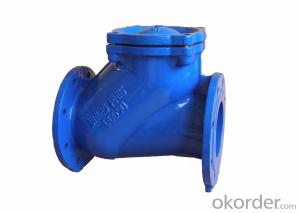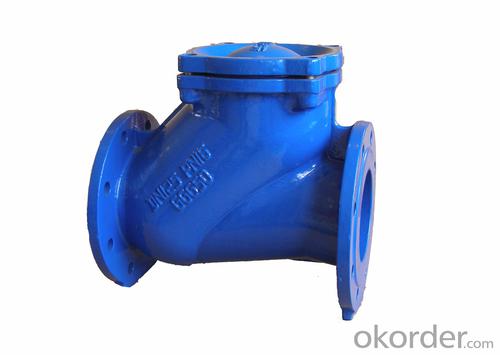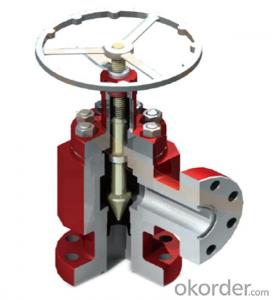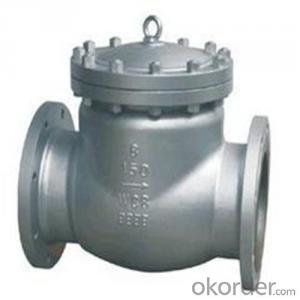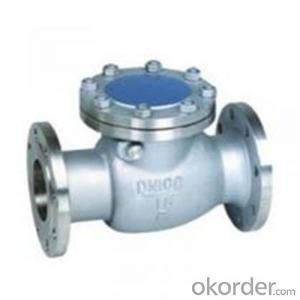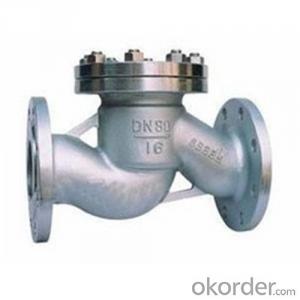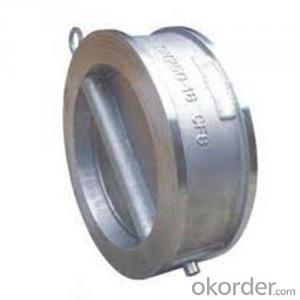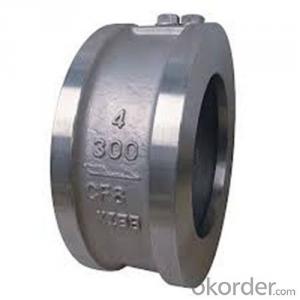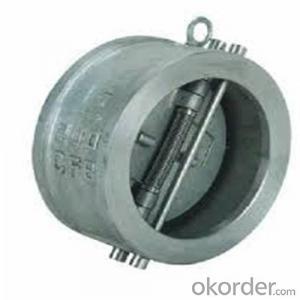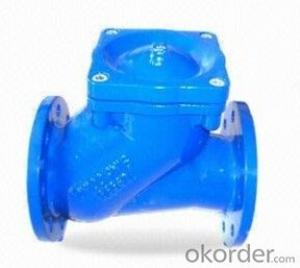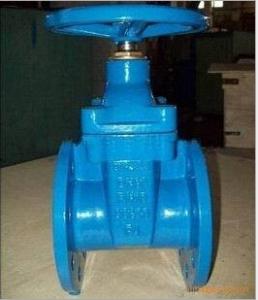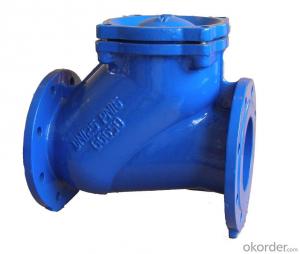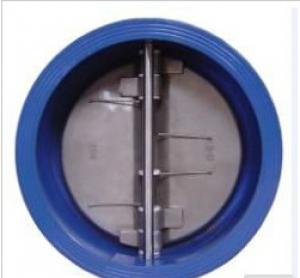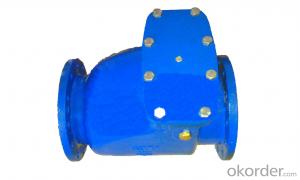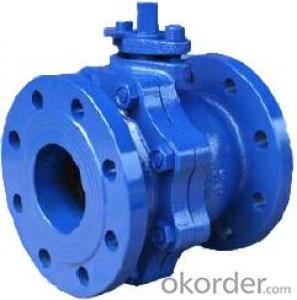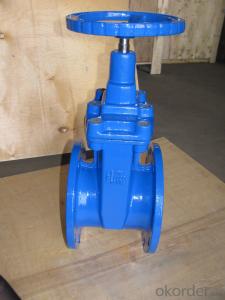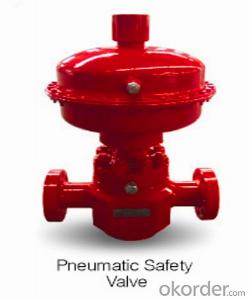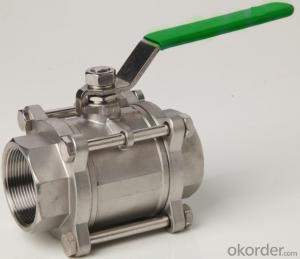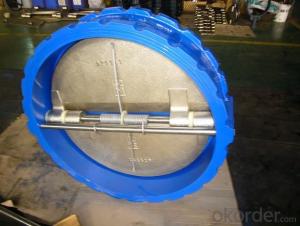Ductile Iron Ball check valve
- Loading Port:
- China Main Port
- Payment Terms:
- TT OR LC
- Min Order Qty:
- -
- Supply Capability:
- -
OKorder Service Pledge
OKorder Financial Service
You Might Also Like
Specifications
Double flanged Double Eccentric Butterfly Valve
PN10/16/25
DN100 ~ DN2000
Technical Specifications
- Design and manufacture: EN593, EN1074-1 and 2
- Face to face dimension: EN558-1 Series 14 (DIN3202 F4)
EN558-1 Series 13 (BS5163)
- Flange dimensions and drillling: EN1092-2 PN10/16/25
- Size range: DN100 - DN2000
- Max. working pressure: 1.0/1.6/2.5 MPa
- Inspection test: EN12266
- Working temperature: -15°C to +80°C
- Suitable medium: water
Main Fetures
- Double eccentric disc reduces seal wear and torque
- Body seat ring is welded directly on the body
- Bi-directional flow and low head loss
- Disc sealing ring to be replaceable on pipeline without dismantling the valve
- Body and disc inside and outside epoxy powder coated (min. 250 microns)
- Opening and closing indicators are provided
- Coupling flange for electric actuator in compliance with ISO5211
- Gearbox and electric actuator operation available
Main Parts and Materials
Body and disc: ductile iron EN GJS500-7/400-15
Shafts: stainless steel AISI 420
Body seat ring: stainless steel AISI 304
Disc sealing ring: EPDM or NBR
Retaining ring: stainless steel or ductile iron
Shaft bearing: Du bushes (self lubricating bushes)
Shaft bush: gunmetal
- Q: i was thinkin i needed rings cause my car was smokin like hell and had a bad compression test on one cylinder. anyways i got the head off and my valves are caked with black **** all down one side and the others are completely white. i dont know if when the car turns off if they're supposed to seal but four of them were about a quarter inch off the head. before i tested everything i was smokin like hell and barely runnin and you could hear a knockin sound in the exhaust at the rear of the car. could the head be the problem or still sound like rings??
- Bad rings cause excess blow by in the crankcase causing vapors (heavy) to come from the dipstick tube as well as the valve cover. I can smell the exhaust smell in the breather vapors not just oily smell. Valves mostly cause smoking out the tailpipe as oil enters the cylinder and burns. excess oil usage is common as well. A compression test will indicate bad rings as one or 2 cylinders will read much lower on the gauge. valves can be seen as bad compression as well but often show more in the leak down in the gauge. the condition you stated of the valves is from oil entering the cylinder heads and burning. this is usually valve guides.
- Q: What are a sing of a bad Idle control valve, will this cause bad mpg?
- Generally, a bad ICV will either be stuck open from carbon or dirt making the idle stay too high. Or dead which usually kills the engine when put in gear. Mileage would be affected, but if it idles good, it's probably ok.
- Q: Ok, I recent rebuilt a set of vortec heads, but the valves I got are a bit longer than stock, I believe .1 competition products pn I2552P. I also installed howards cam 98214 springs with 10° locks and retainers, the locks are +.035. I was just wondering if I would have enough spring pressure.
- Get okorder
- Q: Ok I recently changed my pcv valve and today when I was checking my spark plugs I noticed and valve that looked exactly like a pcv valve on the passenger side valve cover iam not sure exactly what this valve is ?? I should note that I changed the pcv valve on the driver side because I noticed that it was just a hose coming out of a rubber grommet and into the back of the carb was that just a breather hose ? Thanks in advance for any info
- to add, support, you can simply soak pcv valve in fuel. the little eliment filter as well. pcv valve is a hard part. rattles when shaken? it's good. elliment filter is not a paper one. it too can merely be soaked. i've seen a few pcv valves that are bad. those were on engines that sat in yards for years and years. oil dried and set. had ridges that did not let the ball rattle. other than that, never seen one go bad. just need cleaning.
- Q: hi guys..What is different between globe valve and stop check globe? Is that stop check globe=SDNR JIS std?
- I am not even sure what you are talking about. a globe valve is a type of valve that can stop the flow by turn a handel on top of the valve. A check valve on let the flow go one way and stops the flow the other way. hope this help Globe valve From Wikipedia, the free encyclopedia Jump to: navigation, search A Globe valve is a device (specifically a type of valve) for regulating flow in a pipeline, consisting of a movable disk-type element and a stationary ring seat in a generally spherical body.[1] Globe Valves are named for their spherical body shape with the two halves of the body being separated by an internal baffle. This has an opening that forms a seat onto which a movable plug[2] can be screwed in to close (or shut) the valve. The plug is also called a disc or disk.[3][4][5] In globe valves, the plug is connected to a stem which is operated by screw action in manual valves. Typically, automated valves use sliding stems. Automated globe valves have a smooth stem rather than threaded and are opened and closed by an actuator assembly. When a globe valve is manually operated, the stem is turned by a handwheel. Although globe valves in the past had the spherical bodies which gave them their name, many modern globe valves do not have much of a spherical shape. However, the term globe valve is still often used for valves that have such an internal mechanism. In plumbing, valves with such a mechanism are also often called stop valves since they don't have the global appearance, but the term stop valve may refer to valves which are used to stop flow even when they have other mechanisms or designs. Globe valves are used for applications requiring throttling and frequent operation. For example, globe valves or valves with a similar mechanism may be used as sampling valves, which are normally shut except when liquid samples are being taken. Since the baffle restricts flow, they're not recommended where full, unobstructed flow is required.
- Q: here are pix's i want to no, if there is a easy fix or does it have 2 b machined thanksi think it use to have a bent valve in it
- There is really no such thing as has to but there is a thing as ought to. You should put good used heads in a machine shop for a clean up and restoration. The worse they are, the more they need new seats, seals, guide clean up with new valves, surfacing and so on.
- Q: how do you adjust the hyd. valves when motor is running?? thanks, jerry swain
- that's puzzling to discover 0 clearance even as the lifters are not any more pumped up. it truly is how I actually have continuously lashed small block chevys, even with the actual undeniable actuality that it may get messy. get rid of one million valve hide, start up engine. Tighten the first rocker nut till the push rod stops spinning lower than the rocker. Then decrease backpedal a million/4-a million/2 turn. Repeat for each and each of the others. This works nicely with new valve practice factors to boot to boot used parts. the downside is oil would drip on warm headers.
- Q: where is the heater control valve on a 1996 volkswagen passat
- There is no Heater Control Valve. Coolant circulates through the heater core continuously. Air flow is directed through the heater core/ac evaporator in the air distribution box under the dash as required by user input. If you have no heat, there are a couple of things that could be wrong. A bad water pump, plugged up heater core, bad blend door/cable, bad Climatronic control head, or a bad actuator/motor. So, what's your question? What is the car doing/not doing that you think it should/should not do?
- Q: Would a 96 saturn egr valve work on a 96 camaro
- what approximately it? are you particular you would be able to desire to repalce the valve itself. they are in a place to be run via a sensor and vacuum traces or if old sufficient as yours would desire to be basically vacuum traces. be sure your vacuum traces are stable, without holes....
- Q: Its a 1981 Monte Carlo SS with a GM 350 crate motor. There is oil all over the heads valve covers. It isn't my car, but I was thinking of buying it..Thank you.
- It needs a new valve cover gasket which is cheap and easy to replace. Gaskets dry up and break from heat and age. Then all that sloshing oil underneath gets out. Loose valve cover bolts can also be a problem. And the valve cover may have been damaged by someone over-tightening the bolts. This thing is a 100 in human years. What happened to the valve cover gasket (rot from heat and age) is just one example of what has probably happened to many things on it - other gaskets, seals, hoses, tires and belts. Have seller prove he did a timing belt change when needed. It needed that at about 100k or 11 years ago. If seller can prove it, then guess what? It now needs another timing belt.
Send your message to us
Ductile Iron Ball check valve
- Loading Port:
- China Main Port
- Payment Terms:
- TT OR LC
- Min Order Qty:
- -
- Supply Capability:
- -
OKorder Service Pledge
OKorder Financial Service
Similar products
Hot products
Hot Searches
Related keywords
